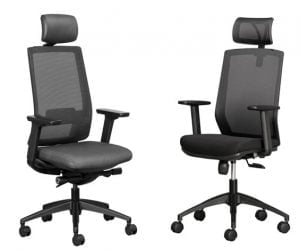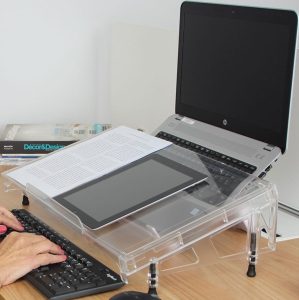
Why a fully adjustable office chair is important
We are all different, so when you buy a new office chair, look for one that has all the adjustability features.
As an office ergonomics risk facilitator, living with chronic nerve pain in my lower back has been a journey filled with challenges and small victories. As someone deeply involved in office ergonomics, I've always emphasized the importance of proper workstation setups and ergonomic practices. Little did I know that I would become a case study myself, discovering first-hand the significance of these principles. I'm excited to share a personal journey as I struggled with nerve pain in my lower back, and discovered how ergonomic chairs alleviated my discomfort and transformed my life at work. What to Know About a Pinched Nerve in the Lower Back - Symptoms & Causes.
My journey with nerve pain in my lower back began gradually and subtly, much like many others. Long hours spent sitting at my desk, focusing intently on ergonomic assessments and office setups, ironically led to neglecting my own posture and comfort. What started as occasional discomfort, soon escalated into persistent lower back pain, affecting not just my work but also my daily life. After consulting my medical professional, I was diagnosed with a pinched nerve in my L2 vertebra. This brought with it constant discomfort and pain that not only affects my spine, but radiates through my lower back muscles, hips, buttocks, and down into my legs. It now serves as a constant reminder of the importance of caring for my body and guiding others, especially in the workplace where most of us spend the majority of our waking hours.
One of the key turning points in my journey towards pain management came when I discovered the profound impact of ergonomic chairs. Because I work for Karo, I was fortunate enough to test various chair options. Due to my specific body shape, finding a chair with armrests low enough to support my arms at a 90-degree angle while still allowing me to comfortably reach my desk, was a real challenge. After several trials, I finally chose to remove the armrests on the OrthoMax Ergonomic Chair and this transformed my work life! By using the desk to support my forearms, I found that I could easily keep the backrest in a free-float position that enables Dynamic Sitting. By doing so, the muscles in my lower back were continuously activated which improved the blood flowing through them. This reduced muscle fatigue as well as the pain in my lower back, core and legs.
I selected the OrthoMax chair because of its amazing features. It has a free float seat that moves freely to create a comfortable angle at the hips and can be locked in a forward tilt or horizontal position. The chair also has a backrest that adjusts in height, which provides excellent support for my lower back. This helps alleviate the pain that stems from my pinched nerve by providing support where I need it most. The real standout feature for me is the adjustable lumbar support which complements the height-adjustable backrest. I found that I could easily adjust the depth and firmness of the lumbar support to cater to my specific needs. Back support for an office chair – why it’s important
Occasionally I would switch to the Fenix chair. The Fenix has a uniquely curved lumbar shaped cushion that extends almost the entire width of the backrest. This curved design snugly fits my lower back and provides the support I need when I have intense pain in my lower back and hips.
Both the Fenix and OrthoMax chairs have seat depth adjustment. This is crucial for me because I have long thighs and need a deeper seat pan.
I've discovered that giving full support to my thighs reduces strain on my lower back.
My journey continued beyond just finding the right chair. Karo supplied me with a height-adjustable or standing desk, which allows me to quickly and easily alternate between sitting and standing throughout the day. This setup has been crucial in reducing pressure on my lower back, easing strain on my spine, and preventing muscle stiffness. I switch between sitting and standing several times daily, especially when I feel my back getting sore or tired. Advantages of a Standing Desk
In addition to improving my ergonomic setup at work, I integrated regular movement into my daily routine. Instead of relying solely on the standing and sitting approach, I incorporated activities like walking to the factory, showroom or my colleagues' desks rather than communicating through email or phone calls. Movement keeps my muscles active and stimulates blood flow throughout my body.

I also regularly perform standing desk back stretches, where I place both hands on the standing desk, bring my feet together, bend at the hips, and lower my upper body between my arms to stretch my back for 30 seconds.
The ultimate ‘how to’ video guide of exercises and stretches for office workers
My experience with nerve pain in my lower back has taught me first-hand the importance of using an ergonomic setup at work.
I've come to realise that a properly adjusted ergonomic chair and standing desk can make a world of difference in alleviating back pain and discomfort. It’s about more than just comfort.....it’s about enhancing productivity, promoting wellbeing, and ensuring long-term health.
If you find yourself struggling with similar challenges, I urge you to evaluate your workstation setup. Take the time to assess your chair, desk, and overall ergonomic arrangement. Small changes, like investing in an ergonomic chair or using a standing desk can have a significant impact on your daily comfort and overall health. By sharing my journey, I aim to inspire and offer advice to anyone facing a similar struggle. Together, we can create work environments that prioritise physical wellbeing, ensuring everyone can work comfortably and productively, free from unnecessary pain and discomfort. Remember our bodies deserve the same ergonomic care and attention that we give to our work tasks. By investing in our health today, we pave the way for a rewarding work life tomorrow.
For further reading, see Can Ergonomic Chairs Help with Sciatica and Pinched Nerves? Insights and Solutions

We are all different, so when you buy a new office chair, look for one that has all the adjustability features.

One of the best ergonomic accessories you can get is a document holder.

Although the upfront cost of ergonomic office chairs may seem high, over their lifespan they are a low-cost and smart investment.


